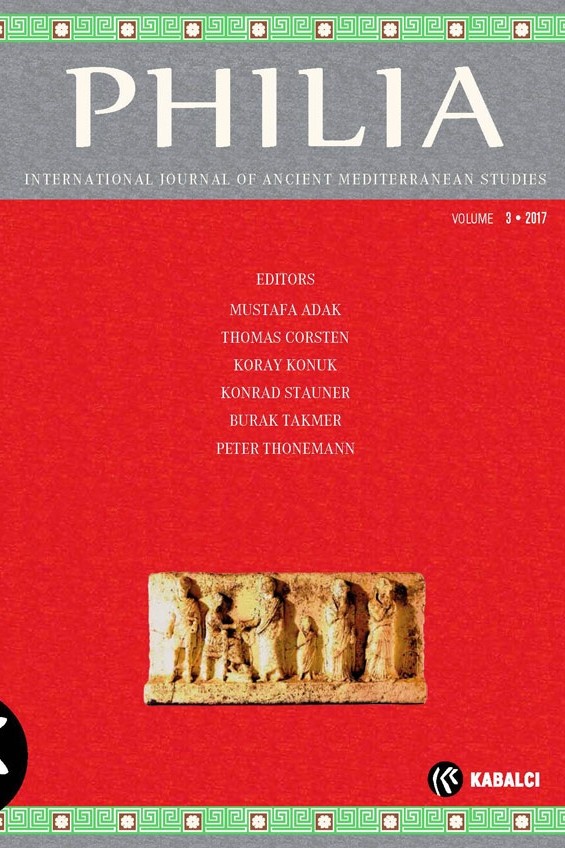Kuzey Anadolu Nehirleri ve Ksenophon’un Anabasis’inin Kronolojisi: An. 5.6’ya Bir Not
On Binlerin Persia seferinin ve Hellas’a Ksenophon’un Anabasis’inde anlatılan uzun yürüyüşünün tarihi bir yüzyıldan uzun bir süredir tartışılmaktadır. Bazı araştırmacılar, Sardeis’ten ayrılış için daha önceki yorumcuların tercih ettiğinden daha geç bir tarihi yeğlemektedir. Daha geç bir kronoloji yönünde bilim dünyasının dikkatinden kaçan bir başka delil, Kuzey Anadolu’daki dört nehrin Sinope elçisi Hekatonymos tarafından Anabasis’in beşinci kitabında verilen tarifinde bulunabilir. Erken kronolojinin önerdiği gibi Hekatonymos’un konuşması Mayıs veya Haziran aylarında yapılmış olsaydı, Yunan ordusu onlara ulaştığında bu nehirler en düşük su seviyesinde olacaklardı. Öte yandan, konuşma daha geç kronolojiye uygun olarak sonbahar yağmurlarının yaklaştığı Ağustos veya Eylül aylarında yapılmış olursa, nehirlerdeki su seviyesinin artması ve Paphlagonia üzerinden karayoluyla ilerlemeye engel olmaları beklenebilir.
North Anatolian Rivers and the Chronology of Xenophon’s Anabasis: A Note on An. 5.6
The dating of the expedition of the Ten Thousand to Persia and their long march home to Greece described in the Anabasis of Xenophon has been debated for over a century. Some researchers now favour a late departure from Sardis over the early date preferred by earlier commentators. One further argument for a late chronology which has failed to attract scholarly attention can be found in the description of four north Anatolian rivers offered by the Sinopean ambassador Hecatonymus in book five of the Anabasis. Had this speech been given in May or June, as according to the early chronology, the rivers would have been at their lowest level by the time the Greek army reached them. If, on the other hand, the speech was held in August or September with the autumn rains approaching, the rivers were likely to swell and present an obstacle to further progress overland through Paphlagonia.
___
- Baslez 1995 M.-F. Baslez, Fleuves et voies d’eau dans l’Anabase, Pallas 43, 1995, 79–88. https://doi.org/10.3406/palla.1995.1362.
- Bekker-Nielsen 2014 T. Bekker-Nielsen, To be or not to be Paphlagonian? A question of identity, in: T. Bekker-Nielsen (ed.), Space, Place and Identity in Northern Anatolia (Geographica Historica, 29), Stuttgart 2014, 63–74.
- Bekker-Nielsen, in press T. Bekker-Nielsen, Navigable Rivers of northern Anatolia, in A. Dan – H.-J. Gehrke – A. Podossinov (eds), The Black Sea in Late Antiquity: spaces, peoples, texts, Stuttgart.
- Beresford 2012 J. Beresford, The Ancient Sailing Season, Leiden 2012.
- Brennan 2008 S. Brennan, Chronological Pointers in Xenophon’s Anabasis, Bulletin of the Institute of Classical Studies 51, 2008, 53–61.
- Dan 2014 A. Dan, Xenophon’s Anabasis and the Common Greek Mental Modelling of Spaces, in: K. Geus – M. Thiering (eds), Features of Common Sense Geo¬graphy: Implicit knowledge structures in ancient geographical texts (Antike Kultur und Geschichte, 16), Berlin 2014, 157–198.
- Flower 2012 M. Flower, Xenophon’s Anabasis, or The Expedition of Cyrus, Oxford 2012.
- Fontanier 1829 V. Fontanier, Voyages en orient, entrepris par ordre du gouvernement francais, de l’année 1821 à l’année 1829: Turquie d’Asie, Paris 1829.
- Gassner 1953 G. Gassner, Der Zug der Zehntausend nach Trapezunt, Abhandlungen der Braun¬-schweigischen Wissenschaftlichen Gesellschaft 5, 1953, 1–35. https:// doi.org/10.24355/dbbs.084–201212071223–0.
- Hay 1994 B. J. Hay, Sediment and water discharge rates of Turkish Black Sea rivers before and after hydropower dam construction, Environmental Geology 23, 1994, 276–283.
- Koch 1850 C. H. E. Koch, Der Zug der Zehntausend, nach Xenophons “Anabasis”, geographisch erläutert und mit einer Uebersichtskarte versehen, Leipzig 1850.
- Lee 2008 J. Lee, A Greek Army on the March: Soldiers and Survival in Xenophon’s Anabasis, Cambridge 2008.
- Lendle 1995 O. Lendle, Kommentar zu Xenophons Anabasis (Bücher 1–7), Darmstadt 1995.
- Manfredi 1986 V. Manfredi, La strada dei Diecimila: Topografia e Geografia dell’Oriente di Senofonte, Milano 1986.
- Paradeisopoulos 2013 I. K. Paradeisopoulos, A Chronology Model for Xenophon’s Anabasis, Greek, Roman and Byzantine Studies 53, 2013, 645–686.
- ISSN: 2149-505X
- Başlangıç: 2015
- Yayıncı: Kabalcı Yayıncılık
Sayıdaki Diğer Makaleler
Zagabas ve Likce B’nin Kullanımı
Efes Artemisionu’na İlişkin Yeni Yazıtlar III: Neopoios Yazıtları
Kuzey Anadolu Nehirleri ve Ksenophon’un Anabasis’inin Kronolojisi: An. 5.6’ya Bir Not
Erken Vespasianus Dönemi Eyalet Valisi ve Consul’u Dillius Aponianus’un Kariyeri Üzerine
Rudolf Heberdey ’ın Arazi Defterlerinden Yeni Haberler: Pisidia Kenti Olbasa’dan Yazıtlar
Asia-Galatia Sınır Kavşağından Odyssea I 4’ü Alıntılayan Bir Mezar Epigramı
